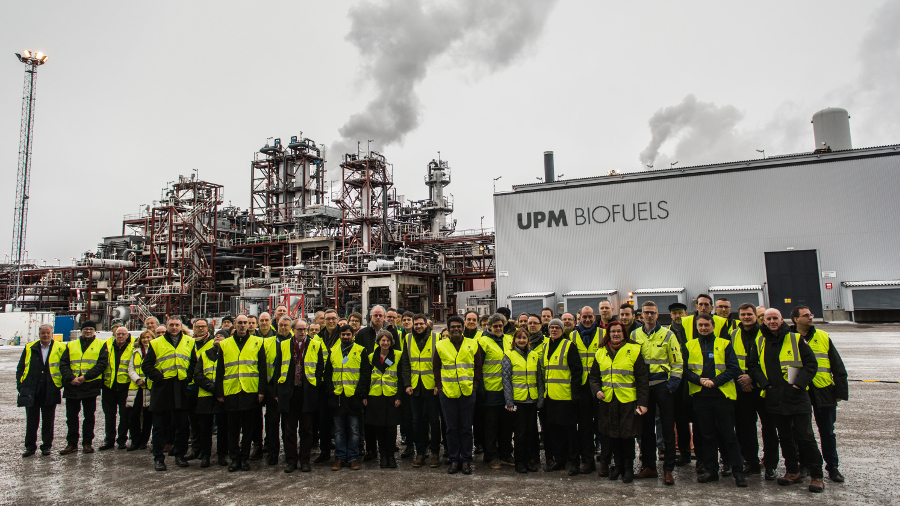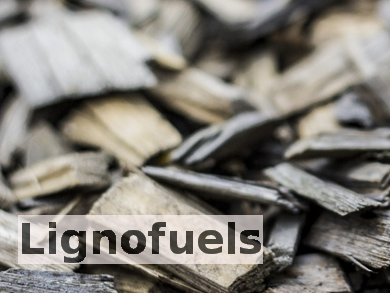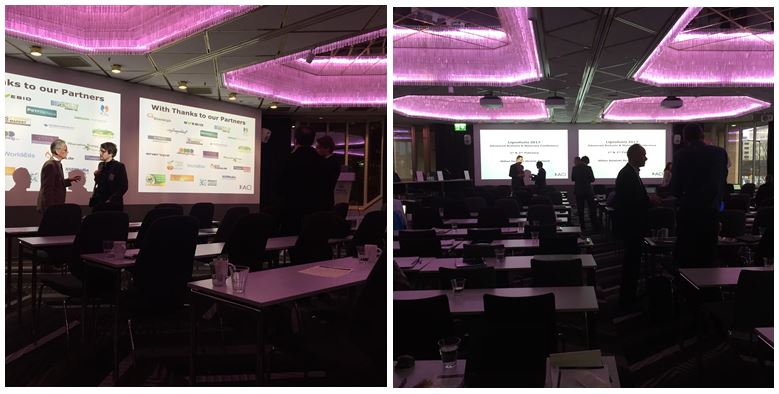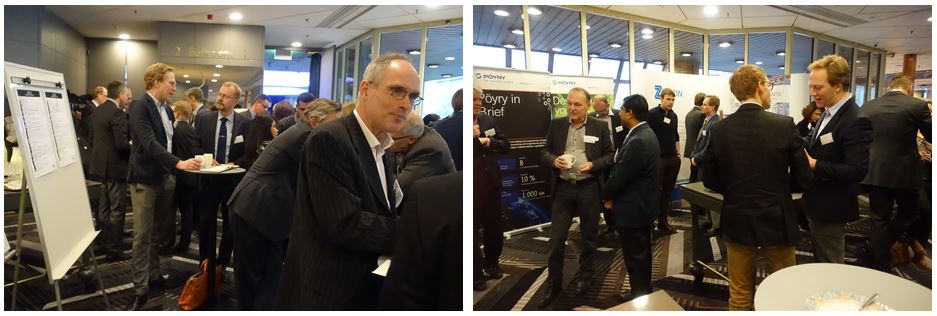Approximately 200 industry experts from Europe but also Australia, India, Brazil, and the US discussed the way forward for biofuels and materials worldwide, the status of legislation in the European market, and the latest developments in biorefineries at the 9th Lignofuels: Advanced Biofuels & Materials congress in Helsinki, Finland. This included the role of biofuels in decarbonizing transport, pre-treatment and hydrolysis processes, the use as jet fuel and marine diesel, pilot plants, latest R&D work, and national perspectives.

Figure 1. Conference opening by Samanta Fawcett, ACI. (Photo by Ville Vauhkonen; Courtesy of UPM Biofuels)
Lignocellulosic Biorefinery and Biodiesel
First-generation (1G) or conventional biofuels are made from sugar (e.g., from sugar cane), starch (e.g., from corn), or vegetable oil (e.g., from rapeseed). Second generation (2G) or advanced biofuels are made from various types of biomasses, waste and residues, or sources of organic carbon and do not compete with food chain. In a lignocellulosic biorefinery, biomass refined from wood, agricultural residues, energy grass, and other plant material is transformed to C6- and C5-sugars (cellulose and hemicellulose) and lignin, a class of aromatic polymers. Lignocellulose is the most abundant biomass, however, severe conditions for disassembling and additional purification steps are required to convert it into liquid fuels and chemical products.
After pretreatment depending on the process design, lignocellulose can be transformed biochemically (fermentation, anaerobic digestion) or thermochemically (e.g., thermal/catalytic/hydro-pyrolysis, gasification) to higher value intermediates or products. In fast pyrolysis, the feedstock is rapidly heated at >100 °Cs–1 to a temperature of 400–600 °C. The liquid yield or bio-oil is a complex mix of hundreds of different organic compounds including anhydrosugars, furanics, aromatics, carboxylic acids, aldehydes, and ketones. A major challenge in using bio-oil as a fuel is its high oxygen content. Effective, deoxygenating processes remain a significant hurdle [1]. Lignofuels can also be produced by hydrotreatening wood-based oils, such as crude tall oil, as raw material.
Lignofuels produced by hydrotreating wood-based oils and 2G fuels are called renewable diesel. Biodiesel refers to fatty acid methyl ester (FAME) and 1G fuels. It has a blending limitation of 7 %. Renewable diesel is chemically the same as petrodiesel and, therefore, can be used as fuel for vehicles either in its pure form or blended into normal diesel. Advanced biofuels have low CO2 emissions or high greenhouse gas emission (GHG) reduction, and achieve zero or low indirect land use change (ILUC) impact. By converting grassland and forests to cropland, atmospheric CO2 levels may increase because grasslands and forests typically absorb high levels of CO2. Lignobased biofuels currently make up less than 10 % of global transportation fuels.
Finnish & European Strategy
As conference host nation, Finland is an exemplary ambassador with regards to lignocellulosic biomass. Overall, the Nordic countries have strong competencies in biorefining technologies and want to send a strong signal to the global community.
Nils-Olof Nylund, Professor at VTT Technical Research Centre of Finland Ltd., Espoo, Finland, introduced the fleet and decarbonization strategy of Helsinki Region Transport (HSL). HSL has tested renewable diesel since 2007 and has cooperated with VTT for about 15 years in research on vehicle performance and alternative fuels.
As advanced after-treatment of the exhaust brings down emissions close to zero, they think that Euro VI vehicles are extremely clean. However, high fuel quality is needed to maintain low emissions. HSL considers the combination of Euro VI vehicles and renewable diesel to be a very good solution for both climate and local air quality.
HSL says that the regulated emissions of a vehicle, mainly NOx and PM (particulate matter), are first and foremost determined by the emission control technology, not the fuel. The carbon intensity of the fuel or the energy carrier is critical for the well-to-wheels (WTW) CO2 emissions, not the vehicle technology. WTW analysis is a modified cradle-to-grave life-cycle analysis. Therefore, CO2 assessment should be carried out on a WTW basis, not looking at tailpipe CO2 emissions only.
HSL’s strategy includes running the bus fleet in Helsinki Region on 100 % biofuels by 2020.

Figure 2. Panelists of the first session. Left to right: Harri Laurikka, CEO, Bioenergia Ry – The Bioenergy Association Of Finland, Nicholas Oksanen, Pöyry, Vantaa, Finland, Sari Mannonen, VicePresident, UPM Biofuels, Lappeenranta, Finland, Riku Huttunen, Director General, Energy Department Of Finland’s Ministry Of Economic Affairs And Employment, Helsinki, Finland, Eric C. Wormslev, Director Innovation, Climate Change & Energy, NIRAS, Copenhagen, Denmark. (Photo by Ville Vauhkonen; Courtesy of UPM Biofuels)
Riku Huttunen, Director General, Energy Department Of Finland’s Ministry Of Economic Affairs And Employment, Helsinki, Finland, spoke about the Finnish energy and climate strategy. Finland is committed to EU’s 2030 energy and climate targets. According to the wealth of a country, the European Commission has outlined different targets for different countries: Sweden, Luxembourg, Denmark, and Finland received the highest targets. Finland has to reduce its emissions of greenhouse gases by 39 % by 2030 compareed to 2005.
Finland is the number three in Europe for renewables (share of renewables in gross final energy consumption). Wood-based biofuels are most produced in Finland.
For the future, Huttunen sees the Finnish economy growing as it does now or even stronger. Till 2030, they want to cut greenhouse gas emissions by 37 % (one-off flexibility mechanism), reduce oil demand by 50 %, and raise the share of renewable transport fuels to 40 %. To make this happen in a cost-effective way, lots of R&D and innovation is needed. The country supports commercialization of new technologies in the EU Emission Trading Scheme (ETS) sector. The main focus is on the promotion of bioenergy and advanced biofuels for transport. [2]
Harri Laurikka, CEO, Bioenergia Ry – The Bioenergy Association Of Finland, Helsinki, Finland, reported on Scandinavian examples of bioenergy. He emphasized that it is important to persistently increase carbon stocks of forests and soil in the long-term while promoting the transition away from fossil fuels instead of only narrowly looking at the short-term annual changes of sinks. Afforestation and forest management should in his opinion be treated as equitably as possible in EU legislation. He also claimed that no closed lists for advanced biofuels should be given by the EU. All non-food-based raw materials including biogas should be treated as advanced biofuels.
Nicholas Oksanen, Pöyry, Vantaa, Finland, gave an overview on the European market regarding advanced biofuels and materials. In his eyes, this is a business which needs to start on a bigger scale. The question is how to make a business out of it. An important boundary condition for such business is that the wood prize is quite stable.
Oksanen sees the pulp mill in transition: While yesterday and today it produced only one product, the future pulp mill will produce one main product as well as additional value added products. Main challenges are in feedstock resourcing (cost of feedstock, supply chain for getting the wood out of the forest) and uncertain policy (oil price, EU legislation and mandates after 2020).
Sari Mannonen, Vice President, UPM Biofuels, Lappeenranta, Finland, presented the company’s way from the pulp and paper business to a wood-based industry producing also new bioproducts such as biofuels, biocomposites, and biochemicals from forest biomass. UPM renewed their business in 2006. With 78 % of Finland covered by wood and with regulation supporting biofuels, UPM sees wood as a versatile raw material. They invested 10 % of their cash flow in R&D towards fuel transformation. They have developed a process to produce renewable diesel in commercial scale with a capacity of 100,000 tonnes per year. The renewable diesel, UPM bioverno, is 100 % made from renewable feedstock, reduces CO2 emissions versus fossil fuel by 80 %, and uses no biomass from the food chain. The company’s process to convert lignin and biofibrills to biochemicals is in market entry stage.

Figure 3. One day before the conference, some conference attendees visited the UPM Lappeenranta Biorefinery, Finland. The first commercial scale wood-based biorefinery. (Photo by Ville Vauhkonen; Courtesy of UPM Biofuels)
Advanced Sustainable Jet Fuel
Aviation is globally responsible for about 2 % of all anthropogenic CO2 equivalent emissions. The growth of aviation is supposed to almost triple emissions by 2050 with over 2.6 Gt/a of CO2 in a baseline scenario [3]. Although the aviation industry has set forth voluntary emission-targets, there is currently no fully functioning commercial supply chain for sustainable jet fuel.
Eric C. Wormslev, Director Innovation, Climate Change & Energy, NIRAS, Copenhagen, Denmark, expects that there is an increasing demand for sustainable jet fuel. Airplanes get lighter and more efficient, batteries and solar panels are impossible to be used, so currently there is no alternative to biofuels. However, sustainable jet fuels are four to five times as costly to produce compared to fossil fuels due to high production costs of sustainable jet fuel and historically low contemporary oil prices. In addition, the lack of an international consensus with regards to what constitutes sustainability makes it difficult to industrially produce sustainable jet fuel. However, Wormslev argues there is a market if somebody could produce such fuel. Airports and countries are putting pressure on airlines and an increasing number of commercial flights operate worldwide on a blend of commissioned biofuels. Nordic countries are the leader in this field in Europe due to their strong competencies in biorefining technology.
In the US, a stable commercial production could be likely in the near future.
Figure 4. During the lectures. © V. Koester
Pilot Plants and New Technologies
So far, the chemical industry is not able to produce 100 % bio-based basic “drop-in” aromatic chemicals (i.e., benzene, toluene, xylenes (BTX)) in an efficient, cost-competitive, and scalable process that uses renewable non-food biomass feedstocks. The thermal catalytic biomass conversion technology (Bio-TCatTM) process, a one-reactor catalytic process, will change this, explained David Sudolsky, CEO, Anellotech, Pearl River, NY, USA, by giving an example of their strategic partnership with the brewing and distilling company group Suntory, Tokyo, Japan. They develop 100 % bio-based PET for sustainable beverage bottles out of bio-p-xylene. The process is currently being tested in a pilot plant.
Advantages include that a solid catalyst in just one fluidized-bed reactor is needed, the hydrocarbon product is substantially free of oxygen, only mild hydrotreating is required to remove trace impurities, and the process uses renewable and readily available non-food materials, such as wood, corn stover, bagasse, which are less expensive compared to processes relying on sugar as a feedstock. The latter also avoids competition with the food chain.
Paul O’Connor, Founder/Director, BIOeCON Inc., Hoevelaken, The Netherlands, introduced a simple, robust, and feedstock-flexible technology that operates under mild conditions and uses ZnCl2·nH2O as an inorganic ionic liquid. Lignocellulose after hemicellulose removal is treated with the molten salt hydrate ZnCl2 medium. Cellulose is dissolved. Then hydrolysis of cellulose to glucose, hydrogenation of glucose to glucitol (sorbitol), and further dehydration to isosorbide takes place. The ZnCl2 hydrate medium intensifies hydrolysis and catalyzes the dehydration [4]. The process has been demonstrated at pilot scale.
Figure 5. Networking break. © V. Koester
Karolien Vanbroekhoven, Program Manager, VITO NV, Mol, Belgium, introduces membrane separation technology as a method within the lignocellulosic value chain. Membrane separation processes have attracted widespread attention in biorefinery applications because they provide low chemical consumption, high energy efficiency, low environmental impact, and outstanding fractionation and separation capabilities. Membranes could be used in various stages of biorefining processes for process intensification, product recovery and purification, and bioenergy production.
Europe’s largest renewable diesel producer, Neste, has a renewable diesel refinery in Singapore and one in Rotterdam, The Netherlands, and also produces renewable diesel in a smaller amount at their Porvoo site in Finland. Based on their NEXBTL technology, they produce renewable diesel, jet fuel, naphtha, propane, and isoalkane. Neste uses various different raw materials and constantly expands its raw materials portfolio. Markku Patajoki, R&D Manager, Biotechnology, Neste, Espoo, Finland, spoke about their experience in lignosellulosic biofuels development and the lengthy and expensive way of bringing a new technology to market. Commercialization normally takes at least ten years once it is ready and costs amount to more than 100 M US$. In this regard, long term stability in regulations should be promoted.
To help speed up commercialization, Thomas Ladrak, Sales Manager, Zeton BV, Enschede, The Netherlands, described how small scale commercial plants can be built in a modular way similar to a prefabricated building. This allows scaling-up and developing innovative process technologies to bring them to market with lower costs, faster, and at a high quality standard, he said. When a concrete soil is available, the plant can be reassembled mechanically within eight days.
Figure 6. Networking break. © ACI
Legislation and Certification
Biofuels reduce GHG and replace fossil fuels. However, concerns about their overall sustainability have been raised. These include the competition with food production, the use of water and other resources to produce biomass, the release of stored carbon, and impacts on biodiversity if land is cleared to grow energy crops.
As biofuels gain market share and the international trading of biomass, raw materials, and biofuels expands, socio-economic sustainability along the whole supply chain has to be ensured. This includes aspects such as land use, agricultural practices, competition with food, energy efficiency, and GHG emissions, as well as life cycle analysis (LCA). Certification procedures need to be applicable at both global and local levels and relate both to small farmers or foresters and large conglomerates.
Schemes that “demonstrate compliance with the sustainability criteria for biofuels” and thus are recognized by the European Commission include ISCC (International Sustainability and Carbon Certification), Bonsucro EU, RTRS EU RED (Round Table on Responsible Soy EU RED), RSB EU RED, 2BSvs (Biomass Biofuels voluntary scheme).
Norbert Schmitz, General Director, ISCC Systems GmbH, Cologne, Germany, certifies agricultural, forestry and alternative feedstocks and products for various markets, including bioenergy and chemical/technical applications. The globally leading certification scheme has system users in 100 countries. 3,500 companies are using ISCC to prove sustainability along their supply chains. Independent auditors do the controls which include checking all the documents and doing controls on the spot. The company importing or producing biofuels pays the scheme.
In November 2016, the European Commission has released its Clean Energy For All Europeans package, better known as winter package. It contains numerous legislative documents outlining the energy policy to meet the Paris COP21 climate change targets [5].
The Renewable Energy Directive (REDII) for the period 2020–2030 sets an EU target for renewable energy in gross final energy consumption of 20 % by 2020. EU countries are also each required to have at least 10 % of their transport fuels come from renewable sources by 2020.
The Effort Sharing Decision gives binding targets for annual greenhouse gas emission for Member States for the period 2013–2020. These targets involve emissions from most sectors not included in the EU Emissions Trading System (EU ETS), such as transport, buildings, agriculture, and waste. The national emission targets have been set on the basis of the relative wealth, measured by Gross Domestic Product (GDP) per capita, of the Member States. They range from a 20 % emissions reduction by 2020 (e.g., Denmark) from 2005 levels to a 20 % increase (e.g., Bulgaria). Collectively, the national targets will by 2020 deliver a reduction of around 10 % in total EU emissions compared with 2005 levels. Together with a 21 % cut in emissions covered by the EU ETS, this will reach the overall emission reduction goal of the climate and energy package, namely a 20 % cut below 1990 levels by 2020.
Timo Huhtisaari, Sustainability And Biofuels Expert, North European Oil Trade Oy, Helsinki, Finland, sees the winter package rather critical and is quite certain that REDII targets will not be met. The global energy trend is that gas, coal, and oil will increase in the next years. Most interesting here is the development of jet fuel in his opinion. As long as fossil jet fuel consumption is increasing, we will not reduce any carbon, Hutisaari said.
To fulfil global decarbonization efforts, it is crucial to have all the feedstock sources available to be able to fulfill the Efforts Sharing Decision. The winter package has to be changed so that efforts are put into the most sustainable and cost-efficient technologies and the demand for alternative fuels is emphasized. He gave an example: E95 (95 % ethanol blend in gasoline) is used in Helsinki and to some extent in Stockholm. It is ethanol with some additives. However, due to the EU excise duties on the sale or use of specific products such as alcohol, they they do not fulfill the EU minimum and are paying twice the tax over diesel in Finland. This shows that it is crucial that excise duties must be levelled between different energies to take energy content and CO2 into consideration. In addition, manufacturer of cars need to be mandated so that they need to have all vehicles to be certified for high concentrate biofuels combined with hybrids. All fossil fuel companies must have an investment obligation into renewable energy.
There is a significant need for advanced ethanol, but not a real market. Huhtisaari thinks that we have to move faster towards creating higher concentrate ethanol blends in gasoline like E20, E85. For car manufacturers like Volkswagen (VW) it seems to not really matter whether it is E20 or 30. One thing he completely misses in the discussions is what is going to happen to the EU Fuel Quality Directive (FQD) after 2020. He also emphazises that ethanol/ethyl-tert-butylether (ETBE) blending allows blending of other biocompounds like low octane bionaphta. Ethanol can replace diesel in heavy duty transport. Advanced ethanol has the largest feedstock basis in global use.
EU’s greenhouse gas reduction targets cannot be met without significant emission cuts in transport. Different types of biofuels will be needed to reach the national targets, thinks Marko Janhunen, Vice President, Stakeholder Relations, UPM Biorefining, Lappeenranta, Finland.
Outlook
The conference showed that there is a lot happening in this young industry which is not profitable yet. At least in Europe there is a lack of investors. Some participants felt that the biofuels industry has to be unified; together they have to look at holistic solutions and benefits instead of fighting for single one and only solutions. “Much of the world’s available biomass is underutilized or inefficiently used,” according to Andrew Lang, Vice President, World Bioenergy Association, Australia. To lead into the right direction, a close exchange and commitment of the research community, industry, and governance is needed.
The 10th edition of Lignofuels will be held in February 2018 in Europe with location due to be finalised alongside pre-conference site visit. For further information do not hesitate to contact Dimitri Pavlyk, ACI, UK, on +44 203 141 0627 or [email protected] or watch the ACI’s webpage.
References
[1] A Perspective on Catalytic Strategies for Deoxygenation in Biomass Pyrolysis, Michael W. Nolte, Brent H. Shanks, Energy Technol. 2017, 5, 7–18. DOI: 10.1002/ente.201600096
[2] Riku Huttunen, Government report on the National Energy and Climate Strategy for 2030, Publications of the Ministry of Economic Affairs and Employment, Finland 2017.
[3] ICAO 2013 Environmental Report, Aviation and Climate Change, Environment Branch of the International Civil Aviation Organization (ICAO), 2013.
[4] Cellulose Conversion to Isosorbide in Molten Salt hydrate Media, Rafael Menegassi de Almeida , Jianrong Li, Christian Nederlof, Paul O’Connor, Michiel Makkee, Jacob A. Moulijn, ChemSusChem 2010. DOI: 10.1002/cssc.200900260
[5] European Commission, Clean Energy for All Europeans package, Brussels, 30 November 2016.
- More conferences organized by ACI
- Special Issue: Pyrolysis for Energy Technologies
Energy Technol. 2017, Volume 5, Issue 1.







